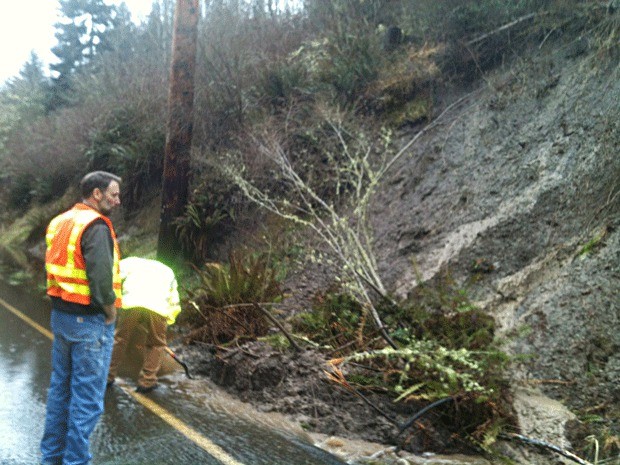Island County road shop crews are keeping their eyes out for mud.
The National Weather Service issued a “special weather statement” this week, warning about increased landslides in a wide swath of Western Washington that includes Whidbey Island.
Sure enough, there was a mudslide in Central Whidbey Thursday — and more may come — but Public Works Director Bill Oakes said he isn’t too worried about something on the scale of the massive Ledgewood Beach landslide, which occurred a year ago this month.
“We are mainly expecting mudslides rather than landslides,” he said.
Oakes explained that a dominant cause of the Ledgewood landslide was groundwater, as was reported by the engineering firm that studied the catastrophe.
It could take months for the rain that falls on the ground this week to percolate down to the level of groundwater. The current rainfall, he said, saturates only the top layer of soil, turning into a “soupy” mess that flows down bluffs and hills.
The Weather Service warned that especially heavy rainfall Wednesday and Thursday, coupled with cumulative rainfall over several weeks, “will put extra pressure on soil instability.”
“The predicted rainfall might be enough to act as a trigger for landslides,” it states, noting that several landslides have already been reported. Steep bluffs, hills and other sheer surfaces are most at risk.
County work crews cleaned up a mudslide on the aptly named North Bluff Road Thursday. It was no big deal, just a little mud on the road, according to Oakes.
Oakes said he sent out the warning about the possibilities of landslides to his road crews. He said they will go and check the places where mudslides have occurred in the past, which is the best predictor where they will happen in the future.
Trouble spots include, Oakes said, North Bluff Road and a couple places on Camano Island.
“Anywhere you have a steep slope and a nearby road, there’s the possibility,” he said.
Likewise, Eric Brooks, deputy director of the county’s Department of Emergency Management, said he has been out checking for signs of impending landslides before the warning was issued.
He said he hasn’t seen anything to worry about.
Oakes checked on the site of the Ledgewood Beach landslide Thursday, but it was just a coincidence that his visit came right after the warning from the Weather Service. He said he checks on the area every month; he found nothing had changed.
The GeoEngineers report on the Ledgewood Beach cites a “buildup of groundwater levels and hydrostatic pressure” and “high seasonal precipitation and cumulative precipitation” as two likely causes.
The report warns that the area “is a high risk of saturation and future movement,” especially during the current winter season.
In other words, a lot of rainwater over time can lead to problems in susceptible areas.
Interestingly, GeoEngineers point out that average precipitation in the county has slowly but steadily increased over the last 113 years.
The report shows the sum of rainfall over 12-month periods plotted on a graph from 1900 to 2013.
The average annual precipitation over 113 years is 20.1 inches. The trend line shows the average increased by a factor of about four inches over those years.
Whatever the cause of the increased wetness, Oakes said, it does point to the possibility of more mudslides and landslides in the future.
Yet Oakes points out that this winter had actually been drier than usual until the recent opening of the skies.
The Weather Service predicts continued showers throughout the weekend and beyond.



